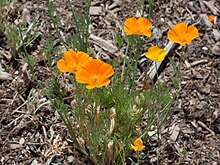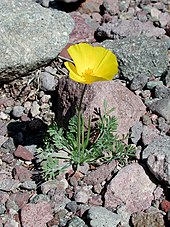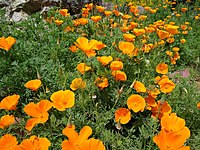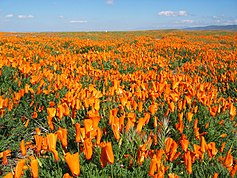bio.wikisort.org - Plant
Eschscholzia californica, the California poppy, golden poppy, California sunlight or cup of gold, is a species of flowering plant in the family Papaveraceae, native to the United States and Mexico. It is cultivated as an ornamental plant flowering in summer (spring in southern Australia), with showy cup-shaped flowers in brilliant shades of red, orange and yellow (occasionally pink and white). It is also used as food or a garnish. It became the official state flower of California in 1903.
| California poppy | |
|---|---|
 | |
Conservation status | |
| Scientific classification | |
| Kingdom: | Plantae |
| Clade: | Tracheophytes |
| Clade: | Angiosperms |
| Clade: | Eudicots |
| Order: | Ranunculales |
| Family: | Papaveraceae |
| Genus: | Eschscholzia |
| Species: | E. californica |
| Binomial name | |
| Eschscholzia californica | |
Description
California Poppy is a perennial or annual plant growing to 5–60 in (13–152 cm) tall with alternately branching glaucous blue-green foliage. The leaves are alternately divided into round, lobed segments. The flowers are solitary on long stems, silky-textured, with four petals, each petal 2 to 6 cm (0.79 to 2.36 in) long and broad; flower color ranges through yellow, orange and red[2] (with some pinks).[2] Flowering occurs from February to September in the northern hemisphere (spring, summer, fall). The petals close at night (or in cold, windy weather) and open again the following morning, although they may remain closed in cloudy weather.[3] The fruit is a slender, dehiscent capsule 3 to 9 cm (1.2 to 3.5 in) long, which splits in two, sometimes explosively with an audible snap, to release numerous small (1.5–1.8 mm wide)[4] black or dark brown seeds. It survives mild winters in its native range, dying completely in colder climates.
Habitat
Its native habitat includes California and extends to Oregon, Washington, Nevada, Arizona, New Mexico, Sonora and northwest Baja California.[3] The Antelope Valley California Poppy Reserve is located in northern Los Angeles County. At the peak of the blooming season, orange flowers seem to cover all 1,745 acres (706 ha) of the reserve. Other prominent locations of California poppy meadows include Bear Valley (Colusa County) and Point Buchon (San Luis Obispo County).
Taxonomy

Eschscholzia californica was the first named species of the genus Eschscholzia, named by the German botanist Adelbert von Chamisso after the Baltic German botanist Johann Friedrich von Eschscholtz, his friend and colleague on Otto von Kotzebue’s scientific expedition to California and the greater Pacific circa 1810 aboard the Russian ship Rurik.

California poppy is highly variable, with over 90 synonyms. Some botanists accept two subspecies — one with four varieties (e.g., Leger and Rice, 2003) — though others do not recognize them as distinct (e.g., Jepson 1993):
- E. californica subsp. californica, native to California, Baja California, and Oregon, widely planted as an ornamental, and an invasive elsewhere (see below).
- E. californica subsp. californica var. californica, which is found along the coast from the San Francisco Peninsula north. They are perennial and somewhat prostrate, with yellow flowers.
- E. californica subsp. californica var. maritima (E. L. Greene) Jeps., which is found along the coast from Monterey south to San Miguel Island. They are perennial, long-lived, glaucous, short in stature, and have extremely prostrate growth and yellow flowers.
- E. californica subsp. californica var. crocea (Benth.) Jeps., which grows in non-arid inland regions. They are perennial, taller, and have orange flowers.
- E. California subsp. californica var. peninsularis (E. L. Greene) Munz, which is an annual or facultative annual growing in arid inland environments.
- E. californica subsp. mexicana (E. L. Greene) C. Clark, the Mexican Gold Poppy, which is found in the Sonoran Desert. Some authorities refer to it as E. Mexicana.[5]
Pollen production
A UK study of meadow flowers that focused on commercial mixes, but which also tested various common plants such as ragwort and dandelion, ranked the California poppy highly in pollen production, although it did not produce a significant amount of nectar. On a per-flower basis it ranked second, with a rate of 8.3±1.1μl. The corn poppy, Papaver rhoeas, topped the list for per-flower pollen production with its rate of 13.3 ± 2.8μl. When measuring the entire capitulum the top two species were the ox-eye daisy, Leucanthemum vulgare, with 15.9 ± 2μl, and Cosmos bipinnatus, which had a rate nearly equivalent to that of the corn poppy.[6] As poppies are not wind-pollinated, their pollen poses no allergy risk via inhalation.
Uses
This section needs additional citations for verification. (July 2020) |
California poppy leaves are used as food or garnish, while the seeds are used in cooking.[7] It has been used as a traditional medicine by indigenous people in California.[citation needed] There are no clinical trials showing it can effectively treat psychiatric disorders in humans.[8]
Chemical compounds
E. californica contains californidine (N+(CH3)2), allocryptopine, eschscholtzine N-CH3 (californidine), and other similar (Papaveraceae) alkaloids.[9]
Cultivation
E. californica is drought-tolerant, self-seeding, and easy to cultivate. It is best grown as an annual in full sun and sandy, well-drained soil or loam.[10] Horticulturalists have produced numerous cultivars with a range of colors and blossom and stem forms. These typically do not breed true on reseeding. Seeds are often sold as mixtures. The following cultivars have gained the Royal Horticultural Society's Award of Garden Merit:-[11]
- 'Apricot Chiffon'[12] (yellow flushed with pink and orange)
- 'Dali'[13] (red)
- 'Rose Chiffon'[14] (pink and white)
Invasive potential
Because of its beauty and ease of growing, the California poppy was introduced into several regions with similar Mediterranean climates. It is commercially sold and widely naturalized in Australia, and was introduced to South Africa, Chile, and Argentina. It is recognized as a potentially invasive species within the United States, although no indications of ill effects have been reported for this plant where it has been introduced outside of California. The golden poppy has been displaced in large areas of its original habitat, such as Southern California, by more invasive exotic species, such as mustard or annual grasses.
Chilean population
In Chile, it was introduced from multiple sources between the mid-19th century and the early 20th century. It appears to have been both intentionally imported as an ornamental garden plant and accidentally introduced along with alfalfa seed grown in California. Since Chile and California have similar climatic regions and have experienced much agricultural exchange, it is perhaps not surprising that it was introduced to Chile. Once there, its perennial forms spread primarily in human-disturbed environments (Leger and Rice, 2003).
The introduced Chilean populations of California poppy appear to be larger and more fecund in their introduced range than in their native range (Leger and Rice, 2003). Introduced populations have been noted to be larger and more reproductively successful than native ones (Elton, 1958), and there has been much speculation as to why. An increase in resource availability, decreased competition, and release from enemy pressure have all been proposed as explanations.
One hypothesis is that the plant's resources devoted in the native range to a defense strategy can, in the absence of enemies, be devoted to increased growth and reproduction (the EICA Hypothesis, Blossey & Nötzold, 1995). However, this is not the case with introduced populations of E. californica in Chile: the Chilean populations were actually more resistant to Californian caterpillars than native populations (Leger and Forister, 2005).
State flower of California


During the 1890s Sarah Plummer Lemmon advocated for the adoption of the golden poppy as the state flower of California, eventually writing the bill passed by the California Legislature and signed by Governor George Pardee in 1903.[15][16][17] As the official state flower of California, Eschscholzia californica is pictured on welcome signs along highways entering California and on official Scenic Route signs.
See also
- Californidine, a chemical compound found in Eschscholzia californica
Notes
- "NatureServe Explorer 2.0".
- "Eschscholzia californica". Royal Horticultural Society, Plant Selector, RHS Gardening.
- "California poppy, golden poppy, copa de oro". Florida Museum of Natural History, University of Florida. Retrieved April 9, 2012.
- "Eschscholzia californica". ucjeps.berkeley.edu. Retrieved May 15, 2021.
- Eschscholzia mexicana at Arizona State University
- Hicks, DM; Ouvrard, P; Baldock, KCR (2016). "Food for Pollinators: Quantifying the Nectar and Pollen Resources of Urban Flower Meadows". PLOS ONE. 11 (6): e0158117. Bibcode:2016PLoSO..1158117H. doi:10.1371/journal.pone.0158117. PMC 4920406. PMID 27341588.
- "Eschscholzia californica - Cham". Plants for a Future. 2012. Retrieved May 8, 2018.
- Sarris, Jerome; Panossian, Alexander; Schweitzer, Isaac; Stough, Con; Scholey, Andrew (December 1, 2011). "Herbal medicine for depression, anxiety and insomnia: A review of psychopharmacology and clinical evidence". European Neuropsychopharmacology. 21 (12): 841–860. doi:10.1016/j.euroneuro.2011.04.002. ISSN 0924-977X.
- Dr. B. Bös (June 4, 2007). "Kalifornischer Goldmohn (Eschscholzia californica) Giftpflanzen Compendium". www.giftpflanzen.com. Retrieved April 12, 2022.
- "Eschscholzia californica". Missouri Botanical Garden. 2018. Retrieved May 8, 2018.
- "AGM Plants - Ornamental" (PDF). Royal Horticultural Society. July 2017. p. 37. Retrieved February 18, 2018.
- "Eschscholzia californica 'Apricot Chiffon' (Thai Silk Series)". Royal Horticultural Society, RHS Plant Selector. 2018.
- "RHS Plant Selector Eschscholzia californica 'Dali' AGM / RHS Gardening". Apps.rhs.org.uk. Retrieved September 15, 2018.
- "RHS Plant Selector Eschscholzia californica 'Rose Chiffon' (Thai Silk Series) AGM / RHS Gardening". Apps.rhs.org.uk. Retrieved September 15, 2018.
- "Sara Allen Plummer Lemmon (1836–1923)", Find-a-Grave.
- Michael Redmon, "Who is responsible for setting up Santa Barbara’s first library?", Santa Barbara Independent, April 10, 2008.
- "California Beat Hero: Sara Plummer Lemmon". California Beat. May 27, 2009. Archived from the original on December 23, 2010. Retrieved December 13, 2016.
References
- Blossey, B.; Nötzold, R. (1995). "Evolution of increased competitive ability in invasive non-indigenous plants: a hypothesis". Ecology. 83 (5): 887–889. doi:10.2307/2261425. JSTOR 2261425. S2CID 15256369.
- Elton, C. S. The ecology of invasions by animals and plants. Chapman & Hall, London.
- Leger, E. A.; Rice, K. J. (2003). "Invasive California poppies (Eschscholzia californica Cham.) grow larger than native individuals under reduced competition". Ecology Letters. 6 (3): 257–264. doi:10.1046/j.1461-0248.2003.00423.x. S2CID 86091323.
- Leger, E. A.; Forister, M. L. (2005). "Increased to generalist herbivores in invasive populations of the California poppy (Eschscholzia californica)". Diversity and Distributions. 11: 311–317. doi:10.1111/j.1366-9516.2005.00165.x. S2CID 86149881.
- Jepson Flora Project (1993): Eschscholzia californica
- Jepson eFlora (2012) Treatment
- The California poppy and its relatives
- Folia: List of California Poppy Cultivars
External links
- Calflora Database: Eschscholzia californica (California poppy)
- USDA Plants profile for Eschscholzia californica (California poppy)
- Jepson eFlora treatment of Eschscholzia californica
- Wondermondo.com: Best locations of California Poppy fields
- Eschscholzia californica — UC Photos gallery
На других языках
- [en] Eschscholzia californica
[es] Eschscholzia californica
Eschscholzia californica es una especie de papaverácea (Papaveraceae), perteneciente a la subfamilia Eschscholzioideae originaria de California (EE. UU.)y Baja California (México), y naturalizada en varias partes del mundo. Se la utiliza como ornamental ya que en la época estival ofrece numerosas flores de color naranja brillante, aunque debe estar expuesta siempre a pleno sol. El género Eschscholzia incluye doce especies oriundas de América del Norte. Su nombres populares son amapola de California, campanilla, dedal de oro,[1]escholtzia, rasete, raso, y fernandos. Esta planta debe su nombre científico al botánico alemán Johann Friedrich von Eschscholtz que la descubrió en California a principios del siglo XIX.[ru] Эшшольция калифорнийская
Эшшольция калифорнийская (лат. Eschscholzia californica) — типовой вид травянистых растений рода Эшшольция (Eschscholzia) семейства Маковые (Papaveraceae). Также называют «калифорнийский золотистый мак» (англ. California goldenpoppy) и «калифорнийский мак» (англ. California poppy). Калифорнийский мак является цветком-символом штата Калифорния.Другой контент может иметь иную лицензию. Перед использованием материалов сайта WikiSort.org внимательно изучите правила лицензирования конкретных элементов наполнения сайта.
WikiSort.org - проект по пересортировке и дополнению контента Википедии










